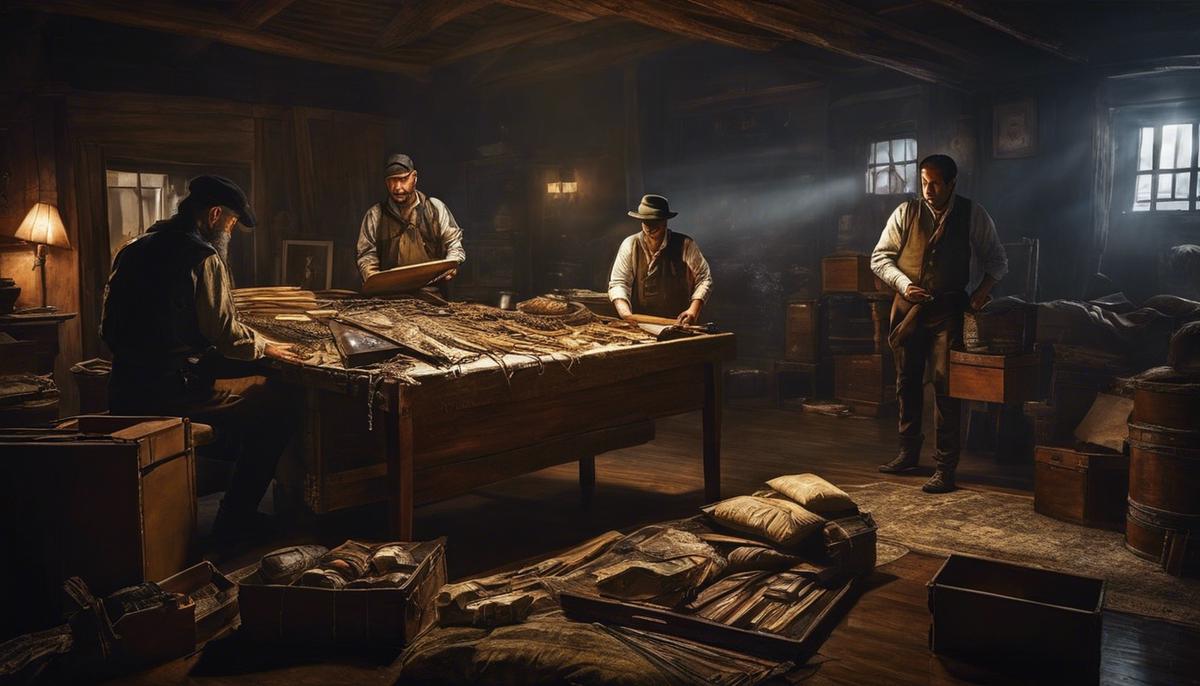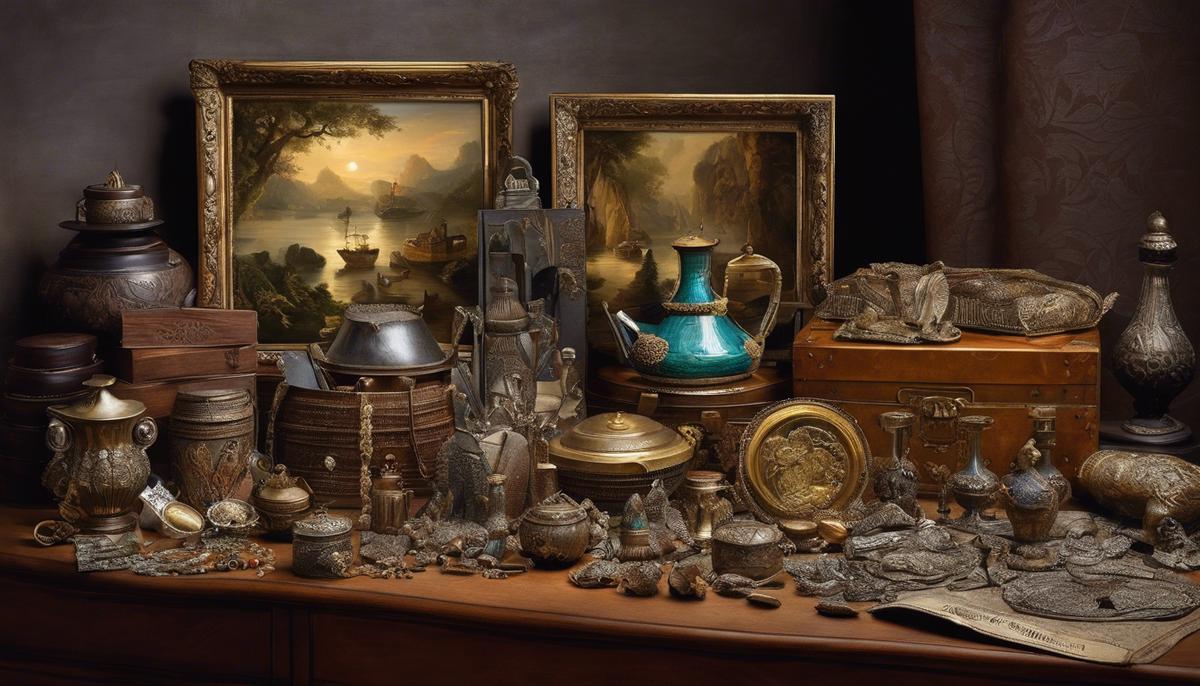Art smuggling, an intricate tapestry of clandestine activities, has permeated society since antiquity, touching upon the dark interstices of our cultural edifice. It is a story that not only thrives where political turmoil and avarice converge but also one that has consistently evolved, mirroring the complex contingencies of each epoch. This essay endeavours to trace the shadowy contours of art smuggling throughout history, delineating its progression from the pillages of ancient empires to the sophisticated criminal networks of the modern era. By charting its course, we embark on an expedition to illuminate the motivations that propel individuals towards such infractions, the ingenuity with which illicit treasures traverse the globe, the consequent afflictions upon our cultural heritage, and the multifaceted battle waged by nations to reclaim their purloined patrimony.
Historical Context of Art Smuggling
Art Smuggling: A Persistent Challenge Through Time
Within the expansive annals of cultural heritage and archaeology lies the troubling narrative of art smuggling, a phenomenon which has undoubtedly plagued the preservation of history since time immemorial. This clandestine activity persists, adapting to the ebb and flow of societal changes with a chameleon’s craft. Herein, we shall delve into an examination of the historic evolution of art smuggling, tracing its sordid steps through history to the present day.
In eras past, the nefarious trade of illicitly-acquired artefacts began to take root. Instances such as the looting of sacred sites and the theft of relics during periods of conquest laid the foundations for what would evolve into a sophisticated black market. The Roman Empire, known for its expansive reach and cultural assimilation, saw the initial surge in the desire for foreign treasures, which often found their way across empires through unscrupulous means.
The Renaissance heralded a new epoch of art as power and affluence became synonymous with the ownership of exquisite works. It was during this period of fervent admiration for classical art that art smuggling found fertile ground to blossom. Collectors and patrons, driven by a voracious appetite for rarities, inadvertently fostered a subculture of art theft and clandestine trade.
Advancements in travel and communication in the 19th and 20th centuries opened new avenues for art traffickers. The chaos and destruction wrought by wars provided a cloak under which art smugglers could operate with impunity, targeting vulnerable art collections and trafficking them across borders with relative ease.
In our current digital age, the challenge of thwarting art smuggling has assumed new complexity. Technological advancements have provided both an arsenal to those safeguarding cultural heritage and a tool for offenders to digress further into the clandestine. Online sales platforms and social media allow for the inconspicuous exchange of unlawful art, demanding ever-more vigilant and sophisticated responses from international law enforcement and cultural institutions.
It is with solemn recognition that one must acknowledge the resilience and cunning adaptation of art smuggling mechanisms. The task of protecting our shared patrimony remains a paramount concern. By maintaining unwavering diligence and fostering international collaboration, there lies hope in curtailing the insidious reach of this cultural scourge and ensuring the preservation and rightful legacy of our global artistic heritage.

Psychology Behind Art Theft and Smuggling
The Complex Web of Incentives Behind Art Smuggling
In exploring the multifarious motives propelling individuals towards the clandestine activity of art smuggling, we illuminate an intricate web of financial, ideological, and psychological incentives.
Financial Gain: Foremost among the lures is, undeniably, the vast economic profit. Artifacts and artworks, particularly those with cultural and historical significance, fetch exorbitant sums on the black market. Smugglers are driven by the potential for monetary enrichment, with some pieces commanding prices in the millions. This lucrative aspect is a powerful accelerator of art smuggling activities.
Prestige and Collecting: Beyond mere financial aspirations, personal prestige plays a significant role. Some smugglers are captivated by the status associated with the possession of rare, often priceless pieces of cultural heritage. The collector’s compulsion, fuelled by a desire to privately own what is deemed public property, both energizes and complicates efforts against art trafficking.
Ideological Motivations: Occasionally, art smuggling is inspired by ideological incentives. It can be utilised as a political tool, with certain individuals or groups purporting to repatriate artifacts taken during historical conflicts, thereby engaging in a controversial form of cultural restitution. This perception of ‘righting the wrongs’ of history adds a complex layer to the pursuit of banned art trade.
Thrill and Challenge: Moreover, one cannot overlook the psychological thrill that characterizes the act of smuggling. The allure of defying legal authorities, coupled with the challenge of executing a successful heist or underground transaction, provides a sense of adventure and empowerment for some individuals. The high-risk nature of smuggling often entices those seeking an adrenaline rush.
Avoiding Legal Consequences: A keen understanding of the limitations of legal frameworks is also evident among smugglers. Exploiting gaps in law enforcement and the challenges of international cooperation, individuals may perceive art smuggling as a low-risk crime, relative to other illicit activities, which can be misleading given the increasing vigilance of cultural institutions and international bodies.
Wealth Redistribution: Some individuals justify art smuggling as an act of wealth redistribution, reasoning that by dispersing artifacts into the hands of private collectors, they are democratizing access to art and history. However, this argument falteringly ignores the cultural disenfranchisement that occurs when heritage pieces are removed from their rightful contexts.
The culmination of these driving forces fosters a persistent and evolving challenge for those dedicated to preserving cultural heritage. With the understanding of these incentives, it becomes evident that efforts to curb art smuggling must be multi-faceted, addressing not only the legal and financial aspects but also the complex human motivations behind this illicit practice. The dedication of scholars, lawmakers, and enforcement agencies remains paramount in this ongoing struggle to protect the art and artifacts that serve as the tangible narrative of human history.

Methods and Routes of Smuggling
In exploring the operational strategies utilised in the clandestine movement of art objects, it is imperative to delve into the versatile methods employed to evade detection. Subterfuge in documentation presents as a paramount tool in art smuggling. At times, artifacts are accompanied by forged provenance or intentionally vague histories, which often attempt to obscure their illicit origins. Moreover, the manipulation of import and export licences is a frequently adopted ploy to feign legitimacy.
Certain art smuggling rings have often historically utilised “mules”, akin to drug trafficking, who unassumingly transport items across borders. These can range from innocent travelers duped into carrying contraband to knowing participants. In more sophisticated operations, smuggled art may be concealed within legitimate cargo, a practice requiring complicity from individuals in shipping and transportation industries.
Additionally, one must regard “free ports” with circumspection. These storage warehouses, often located near shipping hubs, are renowned for lax regulations and tax exemptions. Theoretically designed for the transitory storage of goods, they are exploited for the long-term housing of illicit art, effectively obscuring any paper trail and delaying the entry of objects into a particular legal jurisdiction.
Custom routes too are selected with prudence; items may be routed through countries with more porous borders or those with limited resources for law enforcement scrutiny. Smugglers actively avoid jurisdictions with stringent customs checks and renowned art crime investigative teams.
Furthermore, art smugglers also leverage the private sale and auction sector. Transactions concealed by the discreet nature of private sales can allow for anonymity of both buyer and seller, which minimises scrutiny and diminishes the likelihood of discovery. Auction houses can be misled into selling stolen or undocumented art which has been deliberately misattribated or provided with a falsified history.
In considering the aforementioned methods, it becomes apparent that art smuggling is not merely opportunistic but also characterized by meticulous planning and exploitation of regulatory loopholes. The diverse schemes are tailored to each unique situation, reflecting the adaptability and resourcefulness of those orchestrating these transgressions. It is the responsibility of international law enforcement and cultural institutions to remain vigilant, continuously evolving in response to these persistently innovative smuggling strategies. The safeguarding of our cultural heritage depends on the unwavering commitment to identifying and closing these exploitable gaps within the system.

Impact on Cultural Heritage
The Detrimental Effects of Smuggling on Global Cultural Heritage
Smuggling, an enterprise as old as trade itself, has evolved into a highly sophisticated network of illicit activities that have a devastating impact on global cultural heritage. This nefarious pursuit undermines the integrity of civilizations, stripping them of their historical narratives and robbing future generations of their ancestral connections.
Cultural property, ranging from ancient artefacts to priceless artworks, is often the target of this underworld trade. The objective gains made by pillaging the past are not merely financial but are also tied to social capital—ownership of unique artefacts bestows an air of prestige and exclusivity. Moreover, such acts are sometimes fuelled by ideological beliefs, aiming to rewrite history or suppress cultural identities.
The motivation for this clandestine movement of cultural heritage is multifaceted. Aside from the evident financial incentive and the allure of adding to one’s private collection, there exists a challenge-seeking element. Individuals involved are often drawn to the thrill of evading law enforcement, mastering the art of deception, and the cloak-and-dagger escapades that accompany smuggling. These actors seek to redistribute wealth, albeit illicitly, and avoid any legal retribution by navigating the complex labyrinths of international law.
A common component of smuggling operations is the employment of elaborate tactics to deceive authorities. These can include subterfuge in documentation processes, crafting forged provenances, and developing elaborate false histories for artefacts. Smugglers routinely manipulate import and export licenses, a task made more accessible by the complicity of corrupt officials or the leveraging of intricate regulatory frameworks.
Moreover, the transportation of illicit items is often executed through the use of unwitting or compliant ‘mules’, individuals who convey these artefacts across borders. The concealment of valuable items within legitimate cargo or the utilisation of free ports, which offer tax exemptions and lax regulations, has become a favoured strategy. Criminals carefully select customs routes known for their lack of rigorous checks, thus increasing the chances of smuggling contraband undetected.
The private sale and auction sectors are also manipulated to facilitate the illicit exchange of cultural property. These marketplaces, while reputable, may unwittingly become conduits for unlawfully acquired artefacts. Transactions are often conducted anonymously, with art pieces being misattributed or ownership details falsified to obfuscate the item’s true origins.
The meticulous planning that underscores these acts indicates a profound and troubling exploitation of regulatory loopholes. This level of organised criminal activity poses a significant challenge to those tasked with protecting cultural heritage. The burden rests heavily on law enforcement agencies and cultural institutions to refine their preventive measures, stay abreast of evolving smuggling techniques, and resolve to preserve our global cultural patrimony.
In conclusion, the devastating impact of smuggling on global cultural heritage cannot be overstated. The alarm it raises calls for a more systematic and unified response to ensure the safeguarding of our shared cultural heritage, as these objects of art and history bear the collective soul and memory of humanity.

International Legislation and Cooperation
The Crucial Role of International Law and Cooperative Measures in Countering Art Smuggling
In this comprehensive exploration of measures to combat art smuggling, attention must be turned to the realm of international law and the spectrum of cooperative efforts which, together, form the bulwark against this illicit trade. The complexity of countering art smuggling lies not only in the need for vigilant enforcement but also in cultivating an environment where international parties collaborate seamlessly.
International Legal Frameworks
At the foundation of the fight against the trafficking of cultural property are international legal instruments. The 1970 UNESCO Convention on the Means of Prohibiting and Preventing the Illicit Import, Export, and Transfer of Ownership of Cultural Property serves as the cornerstone. This treaty, to which many nations are signatories, obligates states to implement domestic legislation that deters the unauthorized movement of cultural goods.
Further reinforcing this is the 1995 UNIDROIT Convention on Stolen or Illegally Exported Cultural Objects. This agreement focuses on the restitution and return of cultural items and strengthens legal ownership rights. By providing a uniform treatment of restitution claims, it aims to curb the market for illicit artifacts.
Collaborative Efforts
Effective deterrence of art trafficking demands cooperation at several layers. International agencies such as INTERPOL, the World Customs Organization, and UNESCO have specialized units that work closely to galvanize global responses. Their initiatives include the creation and maintenance of databases of stolen cultural objects, which aid in identifying and repatriating smuggled items.
Capacity Building and Information Sharing
Developing the expertise of individuals in customs, policing, and cultural sectors across countries is a pivotal part of the collective response. Workshops, seminars, and training programs are regularly conducted to fortify the skills needed to identify and rescue cultural artifacts from the clutches of illegal trade.
Information sharing, to this extent, is paramount. Detailed records of thefts, forgeries, and recovered items are imperative for the efficacy of international alerts. Many nations contribute to shared repositories of such information, enhancing the speed and success of investigations.
Regional Alliances and Task Forces
Multinational crime requires multinational solutions. Therefore, regional alliances—such as the European Union’s CULTNET, a network of law enforcement officers specializing in cultural property theft—serve as vital platforms for collaboration. Task forces combining the expertise of multiple agencies often achieve remarkable success in recovering stolen artifacts.
Closing the Market to Trafficked Art
The end goal of these legal and cooperative frameworks is the stringent closure of markets that fuel the trafficking of art. Due diligence requirements for auction houses and galleries, increased vigilance in the art trade, and rigorous scrutiny of provenance are part of the required measures.
Crucially, there needs to be greater public awareness of the implications of art trafficking. Collectors and the general public must be encouraged to demand clear and legitimate histories for artwork acquisitions. The consequences of purchasing trafficked art would thus become a powerful deterrent against sustaining such a market.
In closing, while art smuggling is a scourge with ancient roots and complex contemporary manifestations, the progress in international legal frameworks and cooperative strategies breeds hope. The protection of our global cultural heritage hinges not only on the creation of stringent laws and regulations but also on fostering an ethos of international solidarity and swift joint action. Together, these measures signify a steadfast commitment to preserving the rich tapestry of human history for future generations.

Prevention and Recovery Efforts
Effective Strategies in Preventing and Recovering Smuggled Art: An Analytical Perspective
The illicit trade in cultural property continues to be a blight upon the fabric of global cultural heritage, necessitating a discourse on the most effective strategies for its prevention and recovery. In this context, an examination of systematic methods integrated by international bodies, law enforcement, and cultural institutions merits rigorous attention.
International Legal Frameworks
A cornerstone in the fight against art smuggling is the establishment and enforcement of international legal frameworks. The 1970 UNESCO Convention, for example, has set global precedents for the protection of cultural property. Countries that partake in this convention benefit from a standardized approach to recovery claims and can initiate repatriation procedures for unlawfully exported artifacts. Complementing this, the 1995 UNIDROIT Convention emphasises the importance of due diligence and the role of international law in recovering stolen or illegally exported cultural objects. Rigorous endorsement and application of these frameworks are pivotal in deterring art smuggling.
Collaborative Efforts
Collaboration between countries, law enforcement, and the art trade sector is crucial in dismantling illicit networks. The sharing of best practices, intelligence, and resources can significantly enhance the efficiency of operations aimed at intercepting smuggled art. International cooperation also extends to legal assistance; bilateral treaties and Memoranda of Understanding facilitate the return of stolen artifacts and foster a spirit of upholding cultural integrity worldwide.
Capacity Building and Information Sharing
Enhancing the capabilities of those tasked with safeguarding cultural heritage is a proactive approach to thwarting art smuggling. Training programs focused on art crime investigation techniques, recognition of smuggling patterns, and forensic methods of identifying artifacts are indispensable. Equally important is the creation of databases accessible to customs officials, police, art dealers, and museums, which can alert them to stolen or missing items and provide valuable provenance information.
Regional Alliances and Task Forces
Forming dedicated task forces and alliances specific to regions where art smuggling is prevalent can provide targeted and nuanced responses to local challenges. Examples such as the Carabinieri Command for the Protection of Cultural Heritage in Italy and the Federal Bureau of Investigation’s (FBI) Art Crime Team in the United States demonstrate the effectiveness of specialized units. These dedicated groups bring together expertise and a focused mandate to protect cultural property and repatriate unlawfully obtained art.
Closing the Market to Trafficked Art
Comprehensive due diligence by art market participants plays a vital role in closing the avenues through which trafficked art is bought and sold. Auction houses, dealers, and collectors must adhere strictly to provenance verification processes and actively avoid transactions involving items of dubious origin. Raising awareness and instilling a culture of ethical collecting will diminish the financial incentives that fuel the smuggling of cultural artifacts.
In summation, the multifaceted nature of art smuggling necessitates a tapestry of robust strategies spanning international law, inter-agency collaboration, capacity building, specialized task forces, and responsible market practices. A synergy of these dimensions reinforces the global resolve to preserve cultural heritage and attenuate the market for illicit art. The outcome is a fortified stance against cultural depredation, one which maintains the integrity of human history and collective memory for future generations.

As the vast caravan of purloined artefacts continue to meander through the shadows, echoing the lament of eroded narratives and fractured legacies, our resolve to confront the scourge of art smuggling must be unwavering. This exploration serves as both a lighthouse illuminating the murky waters of art’s underworld and a clarion call for vigilance, activism, and solidarity. It is through our collective diligence, the melding of technology and tenacity, and the weaving of legal sinews that span across continents that we dare to safeguard the sanctity of our shared heritage. As the journey towards a world where art thrives in the sunlight of legitimate appreciation endures, so too does our commitment to stand sentinel over history’s innumerable masterpieces, ensuring they remain the legacy of all mankind, free from the clandestine clutches of the illicit trade.






















